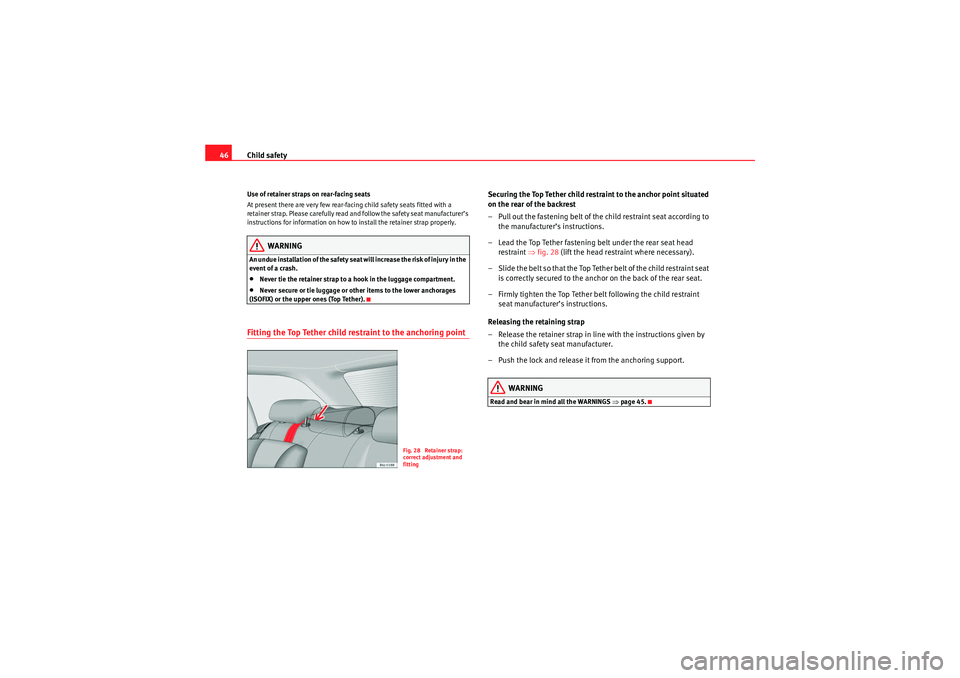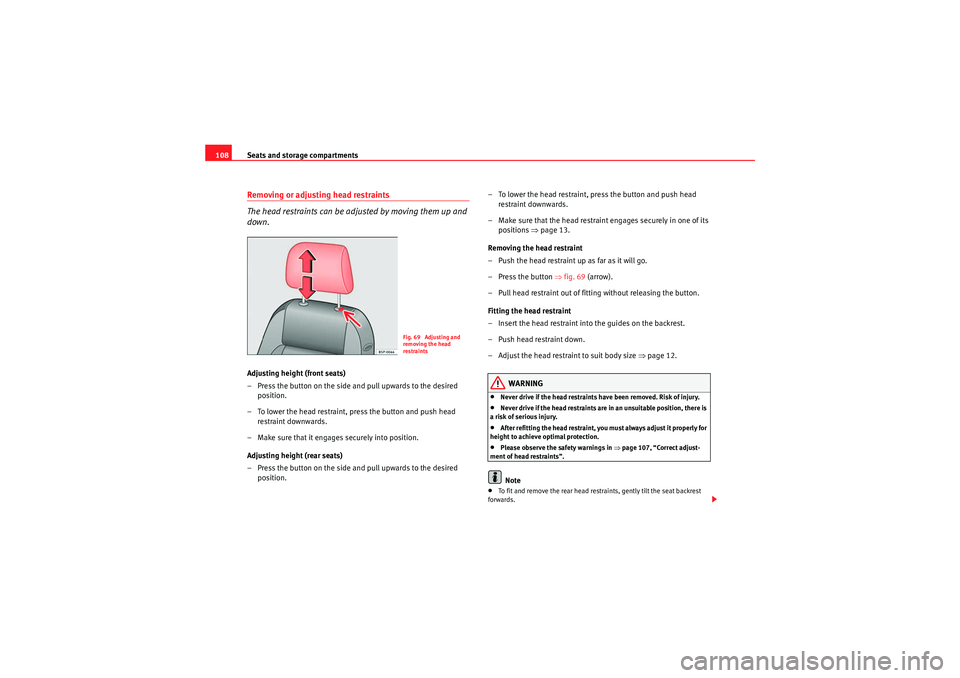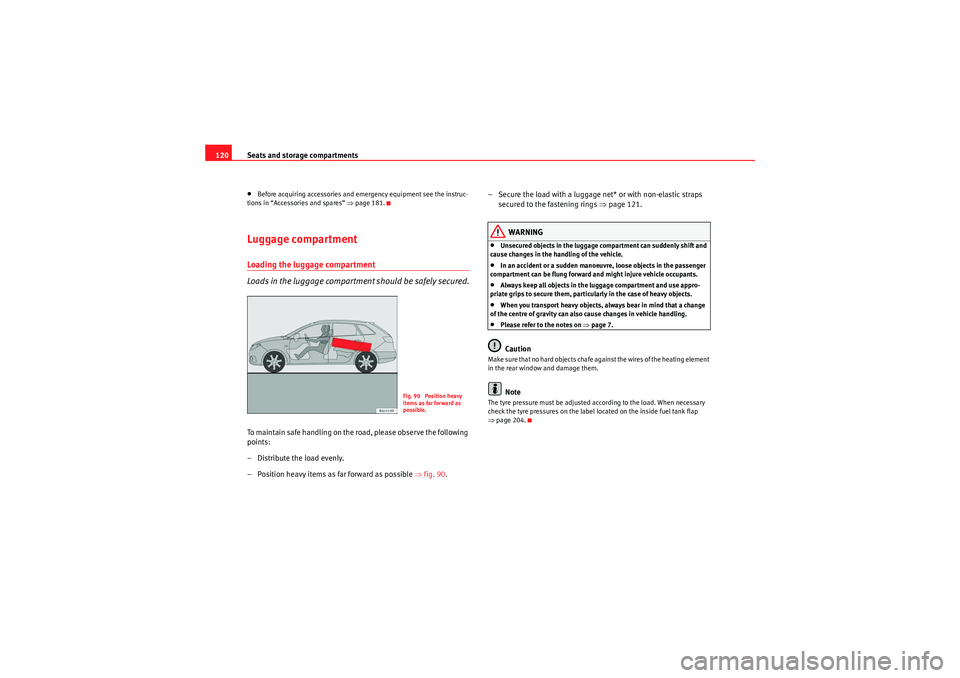2010 Seat Ibiza ST ECU
[x] Cancel search: ECUPage 48 of 264

Child safety
46Use of retainer straps on rear-facing seats
At present there are very few rear-facing child safety seats fitted with a
re ta in er st ra p. P leas e car efull y read an d f ollow t he sa fet y s eat manu fac tur er ’s
instructions for information on how to install the retainer strap properly.
WARNING
An undue installation of the safety seat will increase the risk of injury in the
event of a crash.•Never tie the retainer strap to a hook in the luggage compartment.•Never secure or tie luggage or other items to the lower anchorages
(ISOFIX) or the upper ones (Top Tether).
Fitting the Top Tether child restraint to the anchoring point
Securing the Top Tether child restraint to the anchor point situated
on the rear of the backrest
– Pull out the fastening belt of the child restraint seat according to the manufacturer’s instructions.
– Lead the Top Tether fastening belt under the rear seat head restraint ⇒fig. 28 (lift the head restraint where necessary).
– Slide the belt so that the Top Tether belt of the child restraint seat is correctly secured to the anchor on the back of the rear seat.
– Firmly tighten the Top Tether belt following the child restraint seat manufacturer’s instructions.
Releasing the retaining strap
– Release the retainer strap in line with the instructions given by the child safety seat manufacturer.
– Push the lock and release it from the anchoring support.
WARNING
Read and bear in mind all the WARNINGS ⇒page 45.
Fig. 28 Retainer strap:
correct adjustment and
fitting
IbizaST_EN.book Seite 46 Dienstag, 14. September 2010 1:31 13
Page 76 of 264

Unlocking and locking
74Unlocking and lockingCentral l ocking Description
The central locking system enables you to lock and unlock all
doors by just pushing the button.Central locking can be activated by using any of the following options:•the key , by inserting it into the driver door cylinder and rotating it in the
opening direction. Depending on the vehicle version, either all doors will be
unlocked or only the driver door will be unlocked. All doors will be locked on
locking the vehicle using the key.•the interior central locking button ⇒ page 77.•the remote control , using the buttons on the key ⇒ page 80.
Various functions are available to improve the vehicle safety:
- “Safe*” security system
- Selective unlocking system*
- Self-locking system to prevent involuntary unlocking
- Automatic speed-dependent locking and unlocking system*
- Emergency unlocking systemWARNING
•Locking from the outside carelessly or without good visibility may lead
to bruising, particularly in the case of children.•When locking a vehicle, never leave children unaccompanied inside, as
from the outside it will be difficult to provide assistance if required.
•Having the doors locked prevents an intrusion from getting in, for
example when stopped at a traffic light.Note
For anti-theft security, only the driver door is fitted with a lock cylinder.Safe security system*
This is an anti-theft device that consists of a double lock for
the door locks and a disabling function for the luggage
compartment in order to prevent a forced entry (depending
on country).Activation
The “safe” system is activated when the vehicle is locked using the key or the
remote control.
To activate it with the key, rotate once it is inserted in the door lock cylinder
in the locking direction.
To activate the system using the remote control, press the lock button once on the remote.
Once this system is activated, opening doors from the outside and the inside
is not possible. The tailgate can not be opened. The central locking button
does not work.
WARNING (continued)
IbizaST_EN.book Seite 74 Dienstag, 14. September 2010 1:31 13
Page 79 of 264

Unlocking and locking77
Safety First
Operating Instructions
Practical Tips
Technical Specifications
Central locking button*
The central locking button allows you to lock and unlock the
vehicle from the inside.Locking the vehicle
– Press button ⇒fig. 41 ⇒ .
Unlocking the doors
– Press the button ⇒fig. 41 .The central locking button is still operative when the ignition is switched off.
Except when the Safe security system is activated.
Please note the following if you lock your vehicle with the central locking
button:•For safety reasons it is not possible to open the doors or the tailgate from
the outside (for instance, when stopped at a traffic light).
•The driver door cannot be locked. This avoids the user from forgetting his
key inside the vehicle.•All doors can be locked separately from inside the vehicle. Do this by
pulling the door release lever once .WARNING
•If the vehicle is locked, children and disabled people may be trapped
inside it.•Repeated operation of central locking will prevent the central locking
button from working for a few seconds. Then, it can only be unlocked in
case it has been previously locked. After few seconds, the central locking
becomes operative again.•The central locking button is not operative when the vehicle is locked
from the outside (with the remote control or the key).Note
•Vehicle locked, button.•Vehicle unlocked, button.
Fig. 41 Central locking
button
IbizaST_EN.book Seite 77 Dienstag, 14. September 2010 1:31 13
Page 84 of 264

Unlocking and locking
82Anti-theft alarm system*Description of anti-theft alarm system*
The anti-theft alarm triggers if unauthorised movements are
detected around the vehicle.The anti-theft alarm makes it more difficult to break into the vehicle or steal
it. The system will initiate acoustic and optical warning signals when your
vehicle is tried to be forced.
The anti-theft alarm system is automatically connected on locking the
vehicle. For this, either rotate the key in the locking position or press button
on the radio-frequency remote control*. The system is immediately
activated and the turn signal light located on the driver door will flash along
with the turn signals, indicating that the alarm and the locking security
system (double lock) have been turned on.
If any of the doors or the bonnet are open, they will not be included in the
protection zones of the vehicle when the alarm is connected. If the door or the
bonnet are subsequently closed, they will be automatically included in the
protection areas of the vehicle and the turn signals will flash accordingly
when the doors close.•The turn signal light will flash twice on opening and deactivating the
alarm..•The turn signal light will flash once on closing and activating the alarm.
When does the system trigger an alarm?
The system triggers an alarm if the following unauthorised actions are carried
out when the car is locked:•Opening of vehicle with mechanical key without switching ignition on
within the next 15 seconds•Opening a door
•Opening the bonnet•Opening the tailgate•Ignition switched on with a non-validated key.•Movements in the driving compartment (vehicles with a volume sensor)•Towi ng of t he ve hi cle
8)
•Tilt angle (tow-away protection)
8)
•Undue manipulation of the alarm•Battery handling
The acoustic signals sound and the turn signals flash for approx. 30 seconds.
This may be repeated up to 10 times depending on the country.
How to switch the alarm off
To deactivate the anti-theft alarm, turn the key in the direction, to open, open
the door and switch the ignition on, or press the unlock button on the
remote control.
In ve hicles eq ui ppe d wit h an a nti -t he f t a lar m s yste m , you have 1 5 s e co nds to
insert the key in the ignition lock and activate the ignition if the vehicle is
opened using the driver door key.
Otherwise, the alarm will trigger for 30 sec. and the ignition will be blocked.Note
•After 28 days, the indicator light will be switched off to prevent the battery
from exhausting if the vehicle has been left parked for a long period of time.
The alarm system remains activated.•The alarm will trigger again if attempts are made to open another protec-
tion zone.•The alarm system can be activated or deactivated using the remote
control ⇒page 80.
A2
8)With vehicles fitted with a tow-away protection
IbizaST_EN.book Seite 82 Dienstag, 14. September 2010 1:31 13
Page 110 of 264

Seats and storage compartments
108Removing or adjusting head restraints
The head restraints can be adjusted by moving them up and
down.Adjusting height (front seats)
– Press the button on the side and pull upwards to the desired
position.
– To lower the head restraint, press the button and push head restraint downwards.
– Make sure that it engages securely into position.
Adjusting height (rear seats)
– Press the button on the side and pull upwards to the desired position. – To lower the head restraint, press the button and push head
restraint downwards.
– Make sure that the head restraint engages securely in one of its positions ⇒page 13.
Removing the head restraint
– Push the head restraint up as far as it will go.
–Press the button ⇒ fig. 69 (arrow).
– Pull head restraint out of fitting without releasing the button.
Fitting the head restraint
– Insert the head restraint into the guides on the backrest.
– Push head restraint down.
– Adjust the head restraint to suit body size ⇒page 12.
WARNING
•Never drive if the head restraints have been removed. Risk of injury.•Never drive if the head restraints are in an unsuitable position, there is
a risk of serious injury.•After refitting the head restraint, you must always adjust it properly for
height to achieve optimal protection.•Please observe the safety warnings in ⇒page 107, “Correct adjust-
ment of head restraints”.Note
•To fit and remove the rear head restraints, gently tilt the seat backrest
forwards.
Fig. 69 Adjusting and
removing the head
restraints
IbizaST_EN.book Seite 108 Dienstag, 14. September 2010 1:31 13
Page 111 of 264

Seats and storage compartments109
Safety First
Operating Instructions
Practical Tips
Technical Specifications
•When fitting the head restraints again, insert the tubes as far as possible
into the guides without pressing the button. Front seatsAdjustment of the front seats Adjusting the seat forwards and backwards
– Pull up the grip and move the seat forwards or backwards.
– Then release the grip and move the seat further until the catch engages.
Adjusting seat height
– Pull the lever up or push down (several times if necessary) from its home position. This adjust s the seat height in stages. Adjusting the backrest angle
– Take your weight off the backrest and turn the hand wheel.
WARNING
•Never adjust the driver or front passenger seat while the vehicle is in
motion. While adjusting your seat, you will assume an incorrect sitting
position. Risk of fatal accidents. Adjust the driver or front passenger seat
only when the vehicle is stationary.•To reduce the risk of injury to the driver and front passenger in case of
a sudden braking or an accident, ne ver drive with the backrest tilted
towards the rear. The maximum protection of the seat belt can be achieved
only when the backrests are in an upright position and the driver and front
passenger have properly adjusted their seat belts. The further the back-
rests are tilted to the rear, the greater the risk of injury due to improper
positioning of the belt web!•Exercise caution when securing the seat height into forwards/back-
wards position. Injuries can be caused if the seat height is adjusted
without due care and attention.•To move the seat lengthways, pull upwards and not sideways on the
lever, as the force exerted on it in this position could damage it.
Fig. 70 Front left seat
controls
A1
A1
A2
A3
IbizaST_EN.book Seite 109 Dienstag, 14. September 2010 1:31 13
Page 113 of 264

Seats and storage compartments111
Safety First
Operating Instructions
Practical Tips
Technical Specifications
Rear seatsFolding down rear seats
Folding seat down
– Remove the head restraint ⇒page 108.
– Pull the front edge of the seat cushion ⇒fig. 72 upwards in
the direction of the arrow.
– Lift the cushion forwards in the direction of the arrow.
– Pull the release button ⇒fig. 73 in the direction of the arrow and
fold the backrest forwards
– Insert the head restraints in the spaces on the rear of the seat cushion which are visible when the seat cushion is lowered.
Folding seat forward
– Remove the head restraints from the spaces in the seat cushion.
– Lift the backrest, before securing it, replace the head restraints in
the seat cushion, and then click the seat correctly onto the
locking rails.
– Once the backrest is locked, pull on the central seat belt or directly on the backrest to check that the backrest has properly
engaged in position.
– Check that the position lever is in neutral position.
– Lower the cushion and push it backwards below the seat belt
buckles.
– Press the front part of the cushion downwards.
Fig. 72 Folding up the
rear seat cushionFig. 73 Button for
unlocking the rear back-
rest
A1
A2
IbizaST_EN.book Seite 111 Dienstag, 14. September 2010 1:31 13
Page 122 of 264

Seats and storage compartments
120•Before acquiring accessories and emergency equipment see the instruc-
tions in “Accessories and spares” ⇒page 181.Luggage compartmentLoading the luggage compartment
Loads in the luggage compartment should be safely secured.To ma intain sa fe ha nd l in g o n th e ro ad , please o bse r ve t h e fo ll owin g
points:
– Distribute the load evenly.
– Position heavy items as far forward as possible ⇒fig. 90 . – Secure the load with a luggage net* or with non-elastic straps
secured to the fastening rings ⇒page 121.
WARNING
•Unsecured objects in the luggage compartment can suddenly shift and
cause changes in the handling of the vehicle.•In an accident or a sudden manoeuvre, loose objects in the passenger
compartment can be flung forward and might injure vehicle occupants.•Always keep all objects in the luggage compartment and use appro-
priate grips to secure them, particularly in the case of heavy objects.•When you transport heavy objects, always bear in mind that a change
of the centre of gravity can also cause changes in vehicle handling.•Please refer to the notes on ⇒page 7.Caution
Make sure that no hard objects chafe against the wires of the heating element
in the rear window and damage them.
Note
The tyre pressure must be adjusted according to the load. When necessary
check the tyre pressures on the label located on the inside fuel tank flap
⇒ page 204.
Fig. 90 Position heavy
items as far forward as
possible.
IbizaST_EN.book Seite 120 Dienstag, 14. September 2010 1:31 13